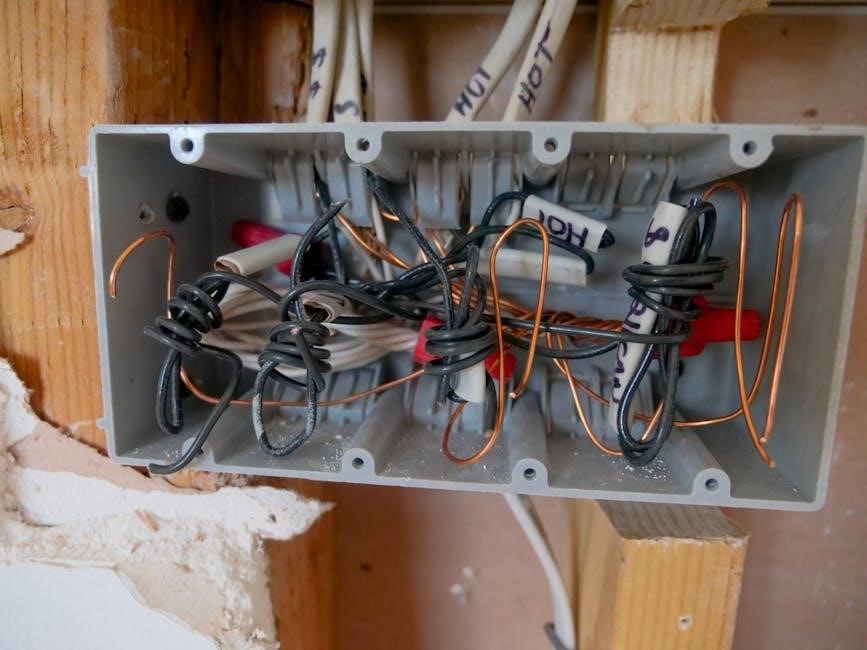
An electrical wiring diagram is a detailed blueprint illustrating the electrical circuit’s components and their connections. It guides installation, troubleshooting, and maintenance of residential electrical systems effectively.
1.1 Importance of Electrical Wiring Diagrams for Home Safety
An electrical wiring diagram is crucial for ensuring home safety by providing a clear visual representation of the circuit connections. It helps identify potential hazards, such as short circuits or overloaded systems, and ensures compliance with safety standards. Proper interpretation of these diagrams prevents electrical fires and shocks, making them indispensable for safe installations and troubleshooting.
1.2 Brief Overview of House Electrical Wiring Systems
A typical house electrical wiring system consists of a main power supply, circuit breakers, and distribution to various components like lighting, outlets, and appliances. It uses either radial or ring wiring configurations to ensure efficient power delivery. The system is designed to safely manage voltage, current, and connections, providing reliable electricity throughout the home while minimizing risks of electrical hazards.
Understanding Electrical Wiring Components
Electrical wiring components include wires, circuit breakers, and outlets, essential for conducting electricity and protecting the system from overloads and short circuits.
2.1 Key Components of a House Wiring System
The essential components of a house wiring system include service lines, circuit breakers, wires, outlets, switches, and grounding systems. These elements work together to ensure safe and efficient electrical distribution throughout the home.
2.2 Electrical Symbols and Their Meanings
Electrical symbols represent components in wiring diagrams, such as lamps, switches, outlets, circuit breakers, and grounding systems. Understanding these symbols is crucial for interpreting diagrams accurately. Common symbols include lines for wires, circles for outlets, and rectangles for switches. These elements help technicians and DIYers identify connections and troubleshoot issues efficiently. Referencing a quick guide ensures accurate interpretations and safe installations.

Safety Precautions for Electrical Wiring
Always turn off power before starting work. Use insulated tools to prevent shocks. Test circuits for live electricity to ensure safe working conditions and avoid accidents.
3.1 Essential Safety Rules for Handling Electrical Systems
When working with electrical systems, always switch off the power and verify it’s de-energized using a voltage tester. Use insulated tools and wear protective gear, including gloves and goggles, to prevent shocks and injuries. Never touch live wires or components to avoid electrocution. Ensure proper grounding of equipment and follow all safety guidelines to minimize risks and ensure a safe working environment. Regularly inspect tools and cables for damage, and avoid overloading circuits to prevent hazards. Always consult a licensed electrician if unsure about any procedure to maintain safety and compliance with electrical standards. Proper training and awareness are crucial for handling electrical systems effectively and safely. By adhering to these rules, you can significantly reduce the risk of accidents and ensure a secure electrical environment for yourself and others. Remember, safety should always be the top priority when dealing with electricity.
3.2 Tools and Materials Needed for Safe Wiring
Essential tools include wire cutters, strippers, pliers, screwdrivers, and a multimeter for voltage testing. Materials like insulated wires, circuit breakers, fuses, and connectors are crucial. Use PVC or nylon cables for durability and safety. Ensure all tools are insulated to prevent electric shocks. Keep a voltage tester handy to confirm de-energized circuits. Proper tools and materials ensure efficient and safe wiring practices, reducing risks and ensuring compliance with electrical standards.
Types of Electrical Wiring Systems
Electrical wiring systems include radial and ring circuits. Radial systems are common in homes, while ring circuits offer efficient power distribution. Both ensure safe and reliable electricity supply.
4.1 Radial Wiring System for Residential Homes
The radial wiring system is a common method for residential electrical installations. It involves a single power supply cable branching out to various circuits and appliances directly. This system is simple, cost-effective, and suitable for most home setups, ensuring efficient power distribution with minimal complexity in installation and maintenance.
4.2 Ring Circuit Wiring System for Efficient Power Distribution
The ring circuit wiring system is a popular method for residential electrical installations. It involves a continuous loop of live and neutral wires connecting multiple sockets and appliances. This system ensures efficient power distribution, reduces voltage drop, and provides higher reliability. It is ideal for homes with multiple high-power appliances, offering a balanced and efficient electrical supply throughout the premises.

How to Read an Electrical Wiring Diagram
Understanding electrical wiring diagrams involves identifying symbols, connections, and pathways. Start by locating the power source, then trace circuits to devices, ensuring safe installation and repairs.
5.1 Identifying Components and Their Connections
Start by recognizing standard electrical symbols, such as outlets, switches, and lighting fixtures. Labels on diagrams indicate voltage, current, and power supply systems. Trace connections between components, ensuring understanding of how devices are linked in series or parallel. Identify the main power source and its distribution to circuits, enabling safe and accurate installations or repairs based on the wiring layout.
5.2 Understanding Circuit Pathways and Load Distribution
Examine how power flows through circuits, ensuring each device is correctly connected. Identify the main power source and distribution points like circuit breakers. Load distribution is crucial, as overloaded circuits can cause safety hazards. Recognize differences between radial and ring wiring systems to balance power effectively and maintain consistent voltage levels throughout the house.
Common Electrical Wiring Diagrams for Homes
Explore single-phase and three-phase wiring diagrams designed for residential use. These diagrams guide installations, troubleshooting, and maintenance, ensuring safe and efficient electrical connections throughout the house.
6.1 Single-Phase Wiring Diagram for Basic Residential Needs
A single-phase wiring diagram is essential for basic residential electrical systems, providing a clear layout for powering lights, outlets, and appliances. It simplifies installation and troubleshooting by tracing the circuit pathway from the main panel to various household devices, ensuring safe and efficient energy distribution throughout the home.
6.2 Three-Phase Wiring Diagram for Heavy-Duty Applications
A three-phase wiring diagram is designed for heavy-duty electrical systems, often used in industrial or large residential settings. It provides higher power efficiency and supports large appliances like air conditioning units or electric heaters. This system reduces the need for multiple conductors and ensures balanced power distribution, making it ideal for high-energy demands while maintaining safety and efficiency.

Troubleshooting Electrical Issues Using Diagrams
Electrical wiring diagrams help identify faults by tracing circuit pathways, enabling quick detection and resolution of issues like short circuits or open connections effectively.
7.1 Identifying Faults in the Wiring System
Electrical wiring diagrams are essential for pinpointing faults in a house’s wiring system. By analyzing the diagram, you can trace circuit pathways to locate issues like short circuits, open connections, or faulty components. Use a multimeter to measure voltage and resistance, ensuring safe troubleshooting. Identifying faults early prevents further damage and ensures reliable electrical performance. Always follow safety guidelines when inspecting live systems.
7.2 Step-by-Step Guide to Diagnosing Common Problems
Start by reviewing the electrical wiring diagram to trace the circuit pathway. Use a multimeter to measure voltage and resistance at key points. Identify common issues like short circuits, open connections, or overloaded circuits. Prioritize repairs based on severity and ensure all safety protocols are followed. Test the system after fixes to confirm proper functionality. Always refer to the diagram for accurate troubleshooting.

Tools and Materials for Electrical Wiring
Essential tools include wire strippers, pliers, screwdrivers, and multimeters. Key materials are insulated wires, circuit breakers, and connectors, ensuring safe and efficient electrical installations and maintenance.
8.1 Essential Tools for Wiring Projects
Essential tools for wiring projects include wire strippers, needle-nose pliers, screwdrivers, and multimeters. These tools help in safely stripping wires, connecting components, and measuring electrical currents. Additionally, a voltage tester ensures de-energized circuits, while a wire cutter and crimping tool facilitate secure connections. Proper tools are crucial for efficient and safe electrical installations, minimizing errors and potential hazards.
8.2 Recommended Materials for Safe and Durable Wiring
For safe and durable wiring, use high-quality materials like 2.5 mm² PVC-insulated cables, terminal boxes, and casings. Ensure cables meet international standards for fire resistance and insulation. Earth wires and circuit breakers are essential for safety. Use materials compliant with IEC or NEMA standards to prevent electrical hazards and ensure long-lasting installations.

Step-by-Step Guide to Installing Electrical Wiring
This guide outlines planning the wiring layout, preparing tools, and safely implementing the diagram. Ensure compliance with safety standards and use approved materials for reliable connections.
9.1 Planning the Wiring Layout for Your Home
Planning involves assessing power requirements, identifying load centers, and determining cable routes. Use a wiring diagram to map circuits, ensuring efficient power distribution and future flexibility. Consider safety, aesthetics, and local regulations to create a comprehensive layout. Proper planning prevents overloading and ensures reliable electrical connections throughout your home, optimizing functionality and safety.
9.2 Implementing the Wiring Diagram in Practice
Begin by turning off the power supply and verifying circuits with a multimeter. Follow the diagram to install components like outlets, switches, and fixtures. Ensure proper connections, secure wires, and adhere to safety standards. Regularly check the diagram to avoid mistakes, ensuring all systems function safely and efficiently. This step-by-step approach guarantees a reliable electrical setup for your home.
Advanced Topics in Electrical Wiring
Explore smart home automation and renewable energy integration. Discover how to incorporate solar panels and advanced circuit systems for energy efficiency and modern convenience in residential wiring.
10.1 Smart Home Wiring and Automation Systems
Smart home wiring integrates advanced automation systems, enabling seamless control of lighting, security, and appliances. These systems require specialized wiring diagrams to ensure compatibility with smart devices. Proper installation involves hubs, sensors, and voice-controlled interfaces, enhancing home efficiency and convenience. Detailed PDF guides provide step-by-step instructions for installing and configuring these modern electrical setups effectively.
10.2 Solar Panel Wiring Integration for Renewable Energy
Solar panel wiring integrates renewable energy systems into home electrical setups. Detailed diagrams guide the installation of photovoltaic cells, charge controllers, and inverters. Proper wiring ensures efficient energy transfer from panels to the electrical grid or storage systems. PDF guides provide step-by-step instructions for safe and efficient solar panel connections, optimizing energy savings and reducing environmental impact while maintaining system reliability.

Best Practices for Maintaining Electrical Wiring
Regularly inspect wiring for wear, ensure connections are secure, and replace damaged components promptly. Use high-quality materials and follow safety guidelines to prevent hazards and ensure reliability.
11.1 Regular Inspection and Maintenance Tips
Regularly inspect wiring for signs of wear, fraying, or damage. Ensure all connections are tight and secure. Check circuit breakers and fuses for proper function. Replace outdated or damaged components promptly. Use high-quality materials to prevent degradation. Schedule annual professional inspections for hidden issues. Keep electrical wiring diagrams updated for easy reference during maintenance tasks. Prioritize safety to avoid potential hazards and ensure reliable power distribution throughout your home.
11.2 Upgrading Your Wiring System for Future Needs
Upgrading your wiring system ensures it meets future demands, such as smart home automation or renewable energy integration. Consider installing higher-capacity cables and modern materials for durability. Plan for additional circuits to support new appliances or devices. Consult a licensed electrician to assess and implement upgrades safely. This proactive approach enhances efficiency, safety, and adaptability for evolving technological needs and energy requirements.

Resources for Downloading Electrical Wiring Diagrams
Download free PDF guides and manuals for home wiring from trusted websites like Schneider Electric and other reliable platforms. These resources provide detailed diagrams for safe installation and troubleshooting.
12.1 Free PDF Guides and Manuals for Home Wiring
Access comprehensive PDF guides for house wiring, offering detailed diagrams and instructions. These manuals cover basic circuits, safety protocols, and advanced systems, ensuring safe and efficient electrical installations. Download resources from trusted platforms to gain practical insights and troubleshooting tips for various wiring setups and renovations.
12.2 Trusted Websites for Reliable Wiring Diagrams
For accurate and reliable wiring diagrams, visit trusted websites offering free and premium resources. Platforms like www.sgkgdcvinukonda.ac.in and other reputable forums provide detailed guides, ensuring safe and efficient electrical installations. These sites often include comprehensive manuals, troubleshooting tips, and safety protocols, making them indispensable for homeowners and professionals alike.

Common Mistakes to Avoid in Electrical Wiring
Common errors include overloaded circuits, improper connections, and ignoring safety protocols. These mistakes can lead to electrical hazards, requiring careful adherence to wiring diagrams and guidelines to ensure safety and efficiency.
13.1 DIY Wiring Errors and How to Prevent Them
DIY wiring errors often stem from incorrect connections, overloaded circuits, and insufficient grounding. To prevent these, always follow electrical diagrams, use appropriate tools, and consult professionals for complex tasks. Proper planning and adherence to safety guidelines can mitigate risks and ensure a safe, efficient wiring system for your home.
13.2 Overloading Circuits and Other Safety Hazards
Overloading circuits is a common safety hazard, causing overheating and potential fires. Identify circuit capacity using wiring diagrams and avoid excessive appliance connections. Ensure all circuits have proper grounding and use circuit breakers. Regular inspections and adherence to electrical codes can prevent hazards, ensuring a safe and reliable home wiring system.
Electrical wiring diagrams are essential for safe and efficient home installations. Always follow safety guidelines and consult reliable resources for updates and compliance with electrical standards.
14.1 Summary of Key Concepts and Best Practices
Electrical wiring diagrams are crucial for safe and efficient home installations. Understanding components, connections, and safety protocols ensures compliance with standards. Regular inspections, proper tool usage, and adherence to best practices prevent hazards and extend system longevity. Always refer to reliable resources for updates and future electrical planning to maintain a secure and functional home wiring system.
14.2 Final Tips for Safe and Efficient Electrical Wiring
Always use certified tools and materials, and follow wiring diagrams precisely. Ensure proper insulation and grounding to prevent shocks. Regularly inspect circuits for wear and tear. Avoid overloading outlets to reduce fire risks. Turn off power before starting work and test circuits post-installation. Consult professionals for complex tasks to guarantee safety and efficiency in your home wiring system.

Appendix
This section provides additional resources, including a glossary of electrical terms and a quick reference guide for wiring symbols, ensuring easy access to essential information.
15.1 Glossary of Electrical Terms
A glossary of electrical terms provides clear definitions for components like voltage, current, and resistance, ensuring a solid understanding of concepts used in wiring diagrams.
15.2 Quick Reference Guide for Wiring Symbols
A quick reference guide for wiring symbols helps identify components like switches, outlets, and circuit breakers. Common symbols include circles for switches, squares for outlets, and zigzags for resistors. These symbols simplify diagram interpretation, ensuring accurate connections and safe electrical installations; Understanding them is crucial for reading and implementing wiring diagrams effectively.